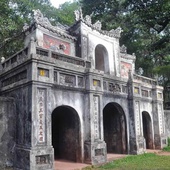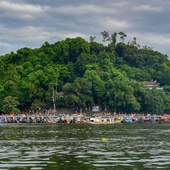Minh Mang Tomb
Touted as the most majestic of all royal tombs, Minh Mang Tomb is a complex of 40 sites.
Location & History
Minh Mang Tomb is in Huong Tho Commune, Huong Tra District, on the west bank of Perfume River and about 12km south of Hue City center. This place is where 2 tributaries join to form the picturesque Perfume River.
 Photo by @luannguyen
Photo by @luannguyen
The tomb was constructed in 1840 under the order of King Minh Mang. After his death in 1841, King Thieu Tri continued the task, according to his father’s plan. The monument was finally completed 2 years later.
Architecture
Touted as the most majestic of all Nguyen Dynasty royal tombs, Minh Mang Tomb is a complex of 40 constructions: palaces, temples, pavilions, etc. Many said that it’s a perfect combination of manmade and natural beauty of Hue, where architecture fits harmoniously into the surrounding landscape.
 Photo by @brunoFcliffet
Photo by @brunoFcliffet
It’s designed as a symmetric axis (called Than Dao) running from the Great Red Gate to the foot of the Surrounding Wall behind the King’s tomb. Apart from this gate at the center, there are 2 other gates: the Left Rad Gate and the Right Red Gate, which led to the Honour Courtyard – where two rows of mandarins, elephants and horse’s stone statues are standing. At the other side of the 3 gates, on Mount Phung Than is the square Stele Pavilion, where the stele “Thanh Duc Than Cong” inscribed with the King’s biography and merits written by his son, is placed. Sung An Temple, where King Minh Mang and his wife are worshipped, can be accessed through Hien Duc Gate. There are 3 stones bridges on the other side of this temple, with the marble one reserved only for the king. Finally, the Hoang Trach Gate heads to the Minh Lau Pavilion. It is placed on top of three terraces representing heaven, earth and water. Closer to the tomb area, the New Moon Lake (Ho Tan Nguyet) is crescent-shaped and embraces the circular wall surrounding the grave (Buu Thanh)
 Photo by @romasVysniauskas
Photo by @romasVysniauskas
Looking from afar, the complex looks like a human being with the hill as his pillow and his hands and feet reaching to the river. From the front gate to the back door is almost 700m. The fence is high but does not block the view to mountains and Cam Ke Hill nearby.
How To Get There
Although traveling by car or motorbike is easy and convenient today thanks to the construction of Tuan Bridge, it’s not a bad choice to take a boat trip from Hue to visit this tomb, in addition to Thien Mu Pagoda and Hon Chen Temple. Tourists should deal with the boat-owners before going. The price ranges, depending on the number of sites and the distance, but normally it’s very reasonable.
Useful Information
- Location: Lăng Minh Mạng, Huế
- Best for: Family, couple, solo
- Entrance: 55,000
- Hours: 7:00 AM - 5:30 PM
- Distance to city center: 8.7km (5.4 mi)

Tu Hieu Pagoda
In Hue - one of Vietnam's most sacred lands of Buddhism, Tu Hieu is regarded as the largest and oldest pagoda, and also a famous sightseeing spot with historical and cultural value.

Hon Chen Temple
Hon Chen Temple is situated on a lovely slope of Ngoc Tran Mountain, 10km upstream from Hue Centre. The name “Ngoc Tran'' means Pearl Bowl, originating from the bowl-shape of the mountain. That also gives the temple its name: Hon Chen.

Hue Imperial Citadel
Famously being one of Vietnam’s seven UNESCO World Heritage Sites, the Imperial City of Hue has long been a must-see attraction for tourists visiting a hidden charm of Vietnam.








